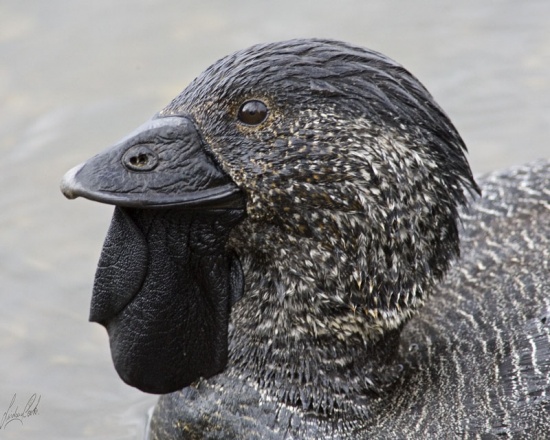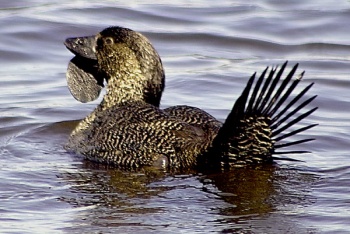(→Taxonomy: Update link) |
|||
| Line 29: | Line 29: | ||
==External Links== | ==External Links== | ||
{{GSearch|Biziura+lobata}} | {{GSearch|Biziura+lobata}} | ||
| − | + | ||
[[Category:Birds]] [[Category:Biziura]] | [[Category:Birds]] [[Category:Biziura]] | ||
Revision as of 21:47, 12 February 2017
| This article is incomplete. This article is missing one or more sections. You can help the BirdForum Opus by expanding it. |
- Biziura lobata
Identification
Male 60 to 70 cm
Distinctive large, leathery lobe underneath the bill, The lobe of skin (bladder) hanging under the drake's bill gets bigger with age. Dark grey-brown plumage.
Female 47 to 55 cm
Distribution
Endemic to Australia. They are common across the southern half of Australia but absent from the more arid country of the north.
Taxonomy
This is a monotypic species[1] and a monotypic genus.
Habitat
Deep, still lakes and wetlands with areas of both open water and reed beds.
Behaviour
Rarely seen in flight or on dry land. They sleep on the water at night, with the head tucked into the body or under a wing.
Shy birds, if they feel under threat, will dive only to resurface some distance away
Diet
Water beetles, yabbies, water snails, freshwater shellfish, a variety of aquatic plants and fish.
Breeding
During courtship the Musk Duck blows its neck and cheeks out and expands the bladder to a diameter of 100-150mm.
The female builds a platform nest with a shallow cup, of plant material. It is usually lined with fine plant matter in tall reeds, in areas of deep water for protection. The clutch consists of 3-4 eggs.





